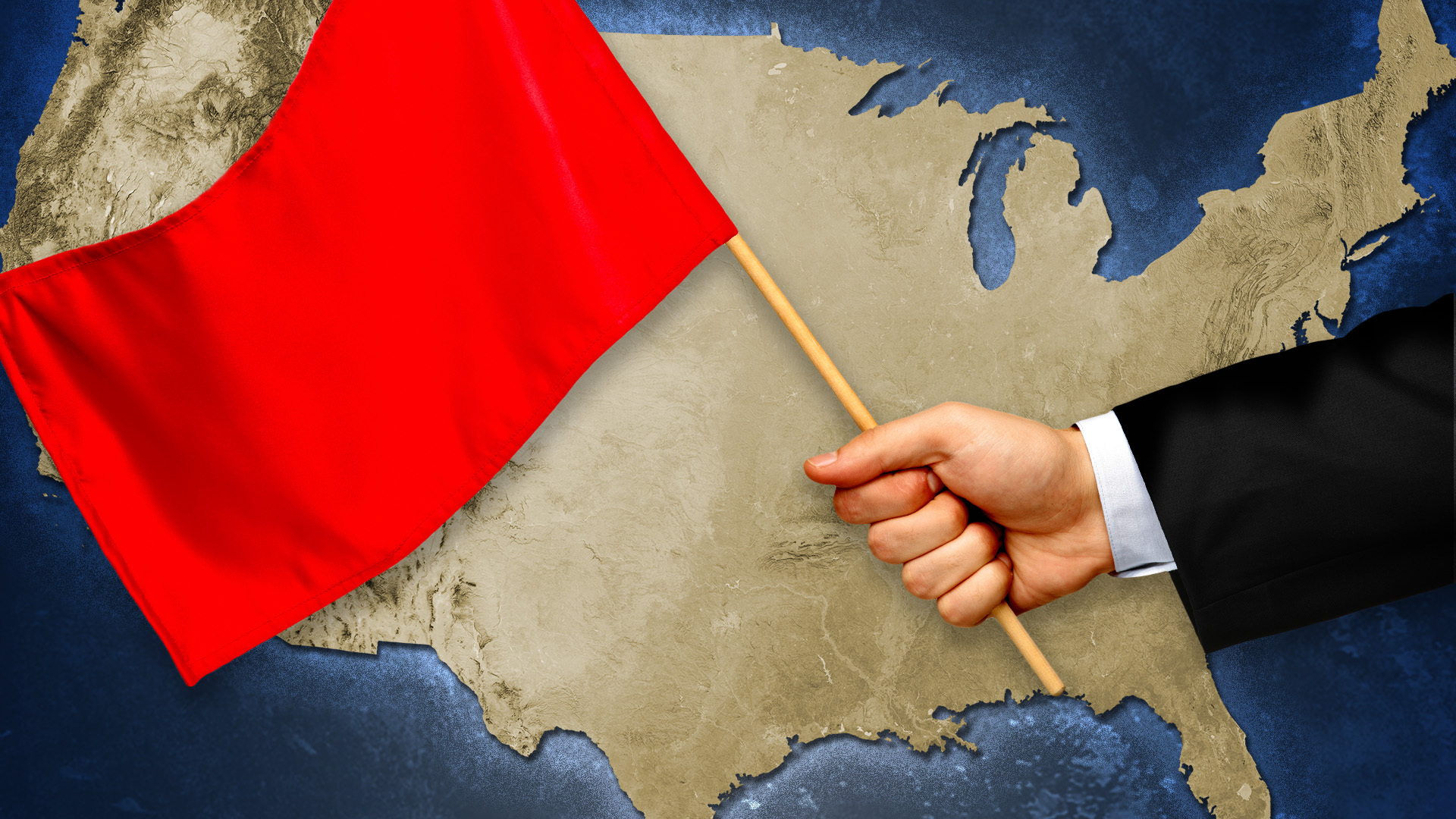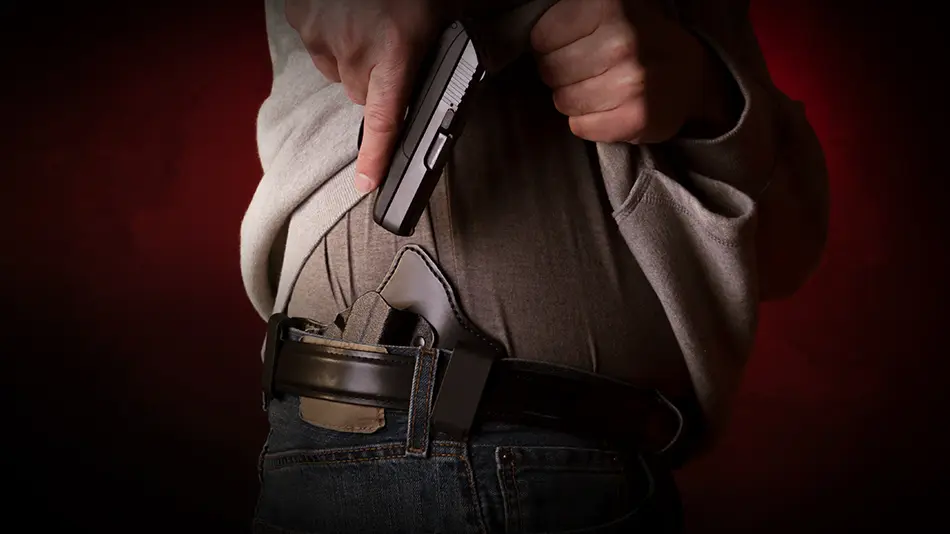
Over the past few years, “Red Flag” laws have been one of the hottest topics in the gun control debate. There’s been a massive push for lawmakers to “do something” and prevent weapons from falling into the hands of people who have mental illnesses. But Red Flag laws are not a new concept, and the issue of how to keep guns out of the hands of individuals who have a mental illness is one that gun rights advocates and politicians have been debating long before the media covered it extensively.
If you’ve ever listened to anyone talk about gun control, you’ve probably heard the term “Red Flag law.” But what are these laws? What do they accomplish that existing regulations don’t? Most importantly, how do Red Flag laws affect law-abiding people like you?
What Are Red Flag Laws?
Red Flag laws are intended to preemptively disarm people who show warning signs that they could be dangerous to themselves and/or others. The term “Red Flag law” is actually a collective nickname for the various court orders states have in place, including: Extreme Risk Firearm Protection Orders (ERFPO), Risk Protection Orders (RPO), Extreme Risk Protection Orders (ERPO), Gun Violence Restraining Orders (GVRO), and risk warrants. When information emerged that there were warning signs that the shooter at Marjory Stoneman Douglas High School in Parkland, Florida in 2018 had mental health issues, legislators across the country began pushing for laws that would take guns away from individuals whose behavior raised a “red flag.”
Some states with Red Flag laws allow a court order to not only remove someone’s current firearms, but to also prevent them from owning, purchasing, possessing, or transporting firearms and ammo while the order is in place. Generally, there’s an initial order that is enforced for a certain amount of time, which varies by state, and most jurisdictions allow the extension of these orders if the person is still deemed at risk of violence to self or others.
How Do Red Flag Laws Work?
The Red Flag law process begins when an authorized party petitions a court to temporarily remove firearms from someone they believe to be a danger to themselves or others. The list of eligible petitioners varies by state but can include law enforcement officials, family members, household members, school officials, health care workers, or even coworkers.
After a petition is filed, the court will hold a hearing in which the concerned party provides evidence to support their claim that the person in question (the “Respondent”) is at risk of harming themselves or others. States use two main standards of proof in these hearings:
- Preponderance of the evidence, or
- Clear and convincing evidence.
(For context, these standards are both lower standards of proof than “beyond a reasonable doubt,” which is the standard required in a criminal trial.)
If the order is granted, the judge may issue a warrant allowing law enforcement officials to search the Respondent’s property and confiscate weapons, sometimes without any prior notice. At that point, most states require the police to arrange safe storage of the firearm(s) for the duration of the order.
Sometimes, the initial hearing is conducted ex parte, meaning the Respondent is not present to defend themselves. If the hearing is ex parte, then the court will schedule another hearing to take place within the following weeks, giving the Respondent the chance to fight the claims. If they’re successful in their defense, the temporary order is dismissed, and the seized firearm(s) will be returned. But if the Respondent is not successful (meaning, the judge rules against them), the order is typically extended (depending on the state).
What Happens if You Violate a Red Flag Law?
If a Red Flag order has been issued against you, then you’re prohibited from possessing firearms and ammo for as long as it’s active—even during the initial temporary period. If you come into possession of any prohibited items, you are in violation of the court order. Most states with Red Flag laws impose criminal penalties for both the unlawful possession of a firearm and the violation of a court order. These penalties differ by state but can include felonies.
For example, under California’s Red Flag law (a GVRO), a person could be prohibited from owning, purchasing, possessing, or transporting firearms and ammo for up to five years, with the potential for the order to be renewed and extended indefinitely.
How Do You Fight a Red Flag Order?
Unfortunately, there isn’t much you can do to fight a Red Flag order. As mentioned earlier, the initial hearing is often an ex parte hearing, so you’re not able to defend yourself or give your side of the story because you’re not there. Also, it’s highly unadvised—not to mention dangerous—to try and fight a Red Flag order by not cooperating with the police officers sent to execute it. Beyond the physical danger, interfering with law enforcement’s duties can lead to numerous different criminal charges.
Either way, the time and place to fight against a Red Flag law order is in court. This is when the judge will determine whether to grant or extend the order, and you have the chance to present your side of things and fight the petition. In the event that the initial order is issued ex parte, you’ll have to give up any weapons initially when police officers come to execute the order. But if your defense is successful, they will be returned.
What States Have Red Flag Laws?
As of 2023, there are 21 states (plus D.C.) that have some sort of Red Flag law in place:
- California
- Colorado
- Connecticut
- District of Columbia
- Delaware
- Florida
- Hawaii
- Illinois
- Indiana
- Maryland
- Massachusetts
- Michigan
- Minnesota
- Nevada
- New Jersey
- New Mexico
- New York
- Oregon
- Rhode Island
- Vermont
- Virginia
- Washington
Several other states have proposed Red Flag law measures of their own but haven’t been successful.
Oklahoma and the Anti-Red Flag Act
Of the states without Red Flag laws, Oklahoma is the only one (at the time of this writing) that has gone so far in the other direction that it has an anti-Red Flag law. The Anti-Red Flag Act (SB 1081) was signed in May 2020 amidst the flurry of Red Flag laws passed by other states in reaction to the school shooting in Parkland. Oklahoma State Sen. Nathan Dahm, author of the measure, said the reason he wanted this kind of law was because he’s concerned the federal government may try to offer grants to states or municipalities to enact Red Flag laws, but “these types of laws are a serious abuse of constitutional rights.” Likewise, Oklahoma State Rep. Jay Steagall, House author of the bill, said Red Flag laws “[strip] American citizens of their rights to due process under the law.”
Oklahoma state legislators have also argued that the current Oklahoma Victim Protective Order procedure is effective enough at keeping firearms out of the hands of those deemed dangerous.
Maine and the Yellow Flag Law
In 2019, Maine passed a sort of Red Flag law compromise that has come to be known as a “Yellow Flag” law. It’s essentially a Red Flag law, but with an additional requirement that has made it significantly more popular than the standard Red Flag laws and extreme risk protection orders. Before a court order to confiscate weapons may be issued, there must be an assessment by a medical practitioner specifically finding that the person in question poses “a substantial risk in the foreseeable future of serious physical harm” to themselves or others based on recent behaviors. In practice, this requirement makes it considerably more difficult to successfully petition the courts to have someone’s firearm(s) removed.
Enjoying this content? Find out how you can get more sent straight to your inbox.
Is There a Federal Red Flag Law?
As of this writing, there are currently no federal Red Flag laws in place. However, there have been several bills introduced at the federal level over the years that have proposed one. In fact, both the Trump and Biden presidential administrations publicly supported Red Flag law policies.
President Biden made a federal Red Flag law attempt part of his early agenda, while former President Trump urged Congress to consider Red Flag policy and formed the Federal Commission on School Safety in 2018 (which openly endorsed Red Flag laws). In an even rarer display of bipartisanship, Senate Judiciary Committee members from both parties have stated their support for the Red Flag law and ERPO movement. And when high-profile members of the Republican party (like U.S. Sens. Lindsey Graham (R-S.C.), Marco Rubio (R-Fla.), and Mitch McConnell (R-Ky.) back Red Flag law policy, it makes other party members much more willing to compromise on various versions of these laws. But despite these efforts and all the attention these laws have attracted, attempts at a federal Red Flag law have been unsuccessful so far.
Do Red Flag Laws Violate Constitutional Amendments?
According to rulings and precedents set by various courts (including the U.S. Supreme Court), Red Flag laws don’t inherently violate any constitutional amendments. The courts have recognized that the Second Amendment does not create an absolute right to possess firearms that can’t be restricted under any circumstances. For example, convicted felons and persons determined mentally incompetent are prohibited from possessing firearms. But in that example, individual rights are taken away only after due process of law. Meanwhile, Red Flag laws often allow someone’s rights to be restricted without any prior knowledge or opportunity for defense.
Do Red Flag Laws Work?
Now that you know how Red Flag laws work, you’re probably wondering if they work. If they’re intended to reduce and prevent violence caused by potentially unstable gun owners, do they accomplish that? Are they reducing the number of mass shootings or suicides? Are they saving lives?
First, despite Red Flag laws often being advocated as a way to prevent citizens with mental health issues from owning firearms, they’re mainly used to combat suicide rates. Take Connecticut for example, the first state to enact a Red Flag law in 1999. Passed because of the 1998 mass shooting incident at the Connecticut Lottery headquarters in Newington, Conn. (and enforced much more heavily after the 2007 Virginia Tech mass shooting in Blacksburg, Va.), the law hasn’t had a huge impact on the state’s homicide rates. However, one study found that from 2007 to 2015 the rate of gun-related suicides dropped by 13.7%. Similar results were also seen in Indiana, the second state to enact a Red Flag law in 2005. Other studies estimate that for every 10-20 gun confiscations, one life was saved.
Then Red Flag laws must work, right? Not quite… Although there was a drop in gun-related suicides seen after these states passed a Red Flag law, there was also a spike in non-firearm suicides. So, what does this mean? It means the underlying roots of the issue—such as mental health—are not being addressed.
**Suicide is a serious subject and impacts gun owners far beyond the scope of Red Flag laws. Learn more about what gun owners can do here.**
Future of Red Flag Laws
What is the future of Red Flag laws in America? There’s been more bipartisan support for Red Flag laws than one might think. Former Presidents Barack Obama and George W. Bush both advocated for various “common sense” gun control measures during their term, and the Biden and Trump administrations have both publicly endorsed Red Flag laws specifically.
A 2019 study showed that 77% of Americans support family-initiated ERPOs, and 70% support police-initiated ERPOs. Even more surprising, it reported that 67% of gun owners support ERPOs. Why would gun owners be in favor of something that could take away their rights? Well, the specific wording of the questions asked tended to pose risk orders as simply “temporary removals” and only for those with mental health risks. And who doesn’t want to help solve the mental health crisis?
Despite the massive outcries for “something to be done” after another mass shooting incident makes headlines and all the bipartisan support Red Flag laws are getting on Capitol Hill, no federal Red Flag laws have succeeded. Why? While pro-gun legislators have repeatedly stated their willingness to keep guns out of the hands of dangerous individuals by way of ERPOs, those against guns have refused to accept anything not paired with mandatory universal background check legislation.
Red Flag Laws and You
How can gun owners protect themselves against Red Flag laws? Although there’s not much you can do to stop the process, you can prepare for it. U.S. LawShield® members can have peace of mind knowing Red Flag Coverage is included in every base membership. So, if you’re a member and fall victim to a Red Flag law action, you don’t have to fight it alone. You’ll have U.S. LawShield by your side at every step of the process to help you fight for your constitutional right to keep and bear arms.
Because, honestly, the best thing (and just about the only thing) you can do to counter a Red Flag law order is to know your local laws and come prepared with a strong and solid defense.
Your Protection Starts Here!
The information provided in this publication is intended to provide general information to individuals and is not legal advice. The information included in this publication may not be quoted or referred to in any other publication without the prior written consent of U.S. LawShield, to be given or withheld at our discretion. The information is not a substitute for, and does not replace the advice or representation of a licensed attorney. We strive to ensure the information included in this publication is accurate and current, however, no claim is made to the accuracy of the information and we are not responsible for any consequences that may result from the use of information in this publication. The use of this publication does not create an attorney-client relationship between U.S. LawShield, any independent program attorney, and any individual.





By your definition people like Gascon, Boudin, and Garland could be considered law enforcement “officials”
If they went to a friendly court and cited Liz Cheney or Nancy Pelosi that all Tump voters are “dangerous”, and the friendly court ruled that there was “a preponderance of the evidence that Trump voters were either a danger to themselves or others. What other than, having a large enough police force would stop liberal DAs police chiefs, or Attorney Generals from going over the voter Rolla and launching confiscation raids on all republican gun owners in Red Flag states?
I am not against a Red Flag Law specifically. But, I don’t understand why “ex parte” doesn’t violate the constitutional right to face your accuser in court. The court should not sign the order to remove property “weapons/guns” until it heard the defense’s side.
I’m against red flag laws and hate the liars and troublemakers who believe in causing problems for others just because they don’t I don’t care who might read this u mess with u get blasted
I’m against red flag laws and hate the liars and troublemakers who believe in causing problems for others just because they don’t I don’t care who might read this u mess with me u get blasted